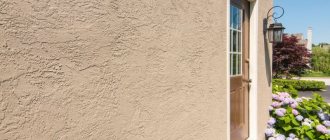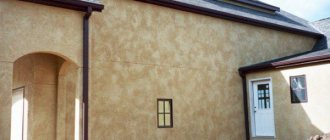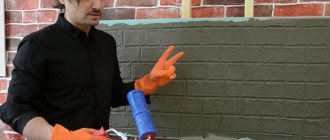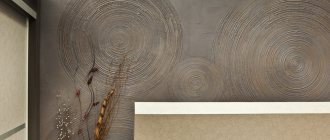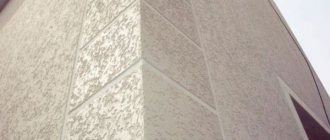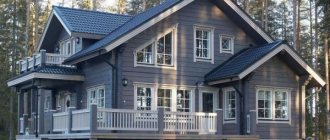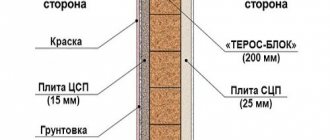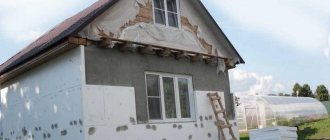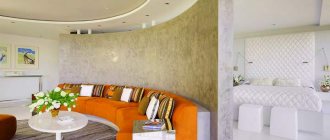To give a house a pleasant appearance, different techniques were used at different times, using different materials. To highlight your own structure among the crowd, you need to try hard. After all, the building should not only look good, but also cope well with its main function - maintaining heat inside the room. To improve the facade of a home, various types of decorative plasters are increasingly used. The work of applying facade decorative mixtures is quite difficult. Having learned all the subtleties and nuances of such finishing, you will be able to do everything yourself without spending extra money.
Description of facade decorative plaster
The very name “plaster” came to us from the Italian language. Derived from the word "Stucco", which can be translated as alabaster, lime or gypsum. It was these materials that formed the basis of the first façade plaster compositions.
The main difference from other finishing materials is that plaster is applied directly to the surface itself , without lathing or frame structures.
This allows you to achieve maximum evenness of the wall, without resorting to sealing small cracks and knocking down protrusions, by only increasing the applied layer of the composition itself. Work on decorating the facade can be carried out either on a bare wall or with an additional thermal insulation layer.
Decorative plaster
Among these requirements:
- rigidity - plaster withstands a variety of mechanical influences well;
- waterproofness – a layer of plaster perfectly protects the walls from atmospheric moisture;
- temperature stability is a quality that is very important for areas with a large difference in winter and summer temperatures;
- vapor permeability – air and moisture circulating through the layer of plaster ensure that the material retains its original structure for a long time;
- sound and heat insulation properties - protect the building from the penetration of cold and noise;
- ease of application;
- a wide selection of textures and colors of modern plasters allows you to decorate the facades of your house in an original way;
- quite affordable cost of materials and work for finishing the house with plaster.
Thus, finishing facades with plaster is a completely modern and at the same time budget option for their design.
Types of decorative plaster for the facade of a house
Depending on the base on which the mixture is created, decorative facade plaster is divided into the following types:
Acrylic
Made from acrylic resin (the same material used to create PVA glue). It is produced ready-made and does not require additional mixing with other materials. Most often used for finishing surfaces with foam and polystyrene foam insulation.
Advantages of using acrylic plaster:
- The acrylic mixture is a vapor-permeable composition, which allows the walls to “breathe” even under a layer of decorative finishing;
- Plaster has the property of increased elasticity , the coating completely closes small cracks and gaps on the wall;
- The composition of the acrylic mixture must include bactericidal additives that protect the facade from the occurrence of fungal formations, dampness and mold.
- The plaster is sold ready-made , which significantly reduces the preparatory stage of façade finishing;
- Wide operating temperature range;
- The surface with an acrylic finish does not absorb moisture and dirt ; it can be washed with ordinary water;
- Acrylic plaster is a quick-drying finishing material.
Disadvantages of using acrylic plaster:
- Has increased electrostaticity. Simply put, dirt and dust easily stick to it.
IMPORTANT!
It is possible to paint the mixture in any color using a special tint.
Acrylic variety
Environmentally friendly plaster "Lamb" is produced by Farbe on an acrylic basis. This material allows you to create a unique texture with grain sizes of 1.5 and 2.0 mm.
At the same time, Farbe plaster is one of the leaders in its class in terms of efficiency . The average material consumption is 2.7-3.1 kg/m2.
Farbe acrylic plasters contain no solvent. It can be applied without any threat to health even in poorly ventilated areas.
Use both inside and outside the building.
One of the most important advantages of Farbe acrylic composition is its resistance to mechanical stress and various environmental influences. This plaster performs well in the harshest climates and protects the house from the sun, snow, rain and wind.
Like any acrylic-based material, “Lamb” plaster can be easily tinted in any of the shades (Symphone, NCS, RAL). Even under the influence of solar radiation, the material is able to retain its original color for 10 years.
Mineral
The fundamental substance of mineral plaster finishing material is cement . It is distinguished by its efficiency, since all elements of the composition have a fairly low price. Available in bags.
Advantages of using mineral plaster:
- Full vapor permeability;
- Resistance to the harmful effects of biological organisms (mold, fungus, etc.);
- Absolutely fireproof material;
- After application and complete drying, such plaster will not shrink or crack ;
- Frost-resistant;
- Moisture resistant;
- Works effectively under the influence of both low and high temperatures;
- Eco-friendly material;
- Does not require additional care, easy to clean;
- Has a relatively low price.
Disadvantages of using mineral plaster:
- Release form: dry substance . To create a ready-made solution, the bagged mixture must be diluted in certain proportions. If the requirements are not met, the composition may become unsuitable for work;
- The installation of such finishing is a rather labor-intensive process and requires the worker to have certain skills and experience working with this kind of material ;
- The narrow range of colors significantly narrows the possibilities of using this plaster. It is possible to give the required shade only with the help of additional coloring of the already dried plastered base, which increases both monetary and labor costs;
- Susceptible to vibration vibrations;
- Guaranteed service life is only 10 years.
NOTE!
Subsequent painting of the plastered surface can only be carried out 2 days after its application.
Mineral variety
Silicone
The basic substance of this composition is silicone resin . It is in many ways similar to acrylic resins, but has higher elasticity. By purchasing such a mixture, you are purchasing a plaster composition that is ready for application.
Advantages of using silicone plaster:
- Thanks to its elasticity , it can tighten both existing cracks and cracks that arise during shrinkage on the façade of a building;
- High biological stability;
- It is a water-repellent finishing material;
- Vapor permeable;
- Even when exposed to low subzero temperatures, it does not lose its properties;
- Possibility of application both manually and mechanically;
- When applied, a strong bond is created between the surface to be plastered and the composition itself;
- Does not have an unpleasant odor ;
- Durability (guaranteed service life - 25 years).
Disadvantages of using silicone plaster:
- High price;
Silicone variety
Plastering facades not only helps solve design problems, but also significantly improves the performance characteristics of any building. A layer of plaster improves thermal insulation, protects load-bearing walls from precipitation and allows you to hide minor construction flaws.
The only drawback of classic plaster is its fragility and high consumption of material. It is much wiser to use polymer-based plaster as a more modern and effective finishing material
Compared to mineral-based materials, Farbe silicone plaster has the following advantages:
- elasticity that prevents the formation of cracks on the walls;
- the ability not to allow moisture to pass into the surface, but at the same time to release vapors outside;
- long-term preservation of the original color even in direct sunlight;
- ability to self-clean with rainwater.
The range of applications for silicone plasters can be expanded due to the possibility of tinting. There are about 2,500 different shades, allowing you to very accurately realize any designer’s plan.
In this case, the service life of the plaster is at least 25 years. In most cases, this means that a cottage that has been plastered once will not require cosmetic repairs until almost the end of its life.
Silicate
The fundamental substance included in this type of material is “liquid” glass . Most often used for plastering facades insulated with mineral wool boards or expanded polystyrene. Sold ready for use.
Advantages of using silicate plaster:
- Not electrostatic;
- Has the property of high elasticity;
- Vapor permeable;
- Hydrophobic;
- Easy to care for;
Disadvantages of using silicate plaster:
- Requires the finisher to have certain knowledge, skills and experience;
- Dries quickly;
- To finish this type of decorative facade plaster, it is necessary to carry out additional preliminary work on priming the base . This significantly increases the time spent decorating the exterior of the building.
Silicone variety
Facade finishing with artificial stone
Facing stone is not a completely “artificial” material, unlike slab materials and siding that imitate its texture. In fact, its base consists of natural rock fragments of various sizes, held together by a binder mixture. It consists of cement, sand, expanded clay, plasticizing and coloring additives.
The weight of tiles made from such stone is close to natural, so this type of finishing is laid directly during the development of the project. The weight of the cladding varies from 20 to 50 kg/sq.m. In addition to it, the walls must also withstand the weight of putty (glue) and grout, which increase the weight by 5–10%.
20. In the project of a country house in the loft style, “wild” stone perfectly emphasizes the design idea
Most often, artificial stone is partially present in the decoration of the facade, highlighting individual elements: base, columns, pipes. Its rough texture goes well with smooth plastered surfaces, creating interesting and unusual combinations. And just as often it is used in the design of private houses along with siding. This significantly saves owners money, and the number of possible options is unlimited.
21. The small fantastic castle is a stylization of a medieval building
22. The project provides for a high ground floor for arranging a garage and utility rooms, part of it serves as a terrace
23. The design of this country cottage contains many elements from different styles (half-timbered, Gothic, English), balanced by the overall color scheme. Decor made of polyurethane foam elements.
Small decor, which used to be made of cement and plaster, but is now made of concrete and fiberglass, helps to make the design of the house individual. The most modern type of products is made of polyurethane. Products in the middle and high price segment have a wood density (300 kg/m3), and their durability is comparable to the period of construction.
The cheapest jewelry is made of polystyrene, covered with a thin layer of plaster, and painting provides additional protection. Expensive varieties have a denser surface layer that is resistant to moisture and frost. Decorative elements are attached to the walls with special glue, and sometimes mechanical fasteners are additionally used.
24. Framing arched windows with polystyrene decorative elements
25. Decorating the pediment with decorative elements
26. Terracotta decorative brick, emphasized by white trim, and white elements create a classic combination
The most popular decorative elements are cornices, pilasters, window frames, and trim. With their help, you can create a house design with a classic, Italian, Victorian look, regardless of what material it is built from. Painting must be carried out no later than 2–4 weeks after installation, since the material changes color under the influence of ultraviolet radiation.
Types of textures of decorative facade plasters
To give the greatest aesthetic appeal, various types of textured application of plaster compositions are used.
Depending on the means and methods of creation, textures are divided into:
- Traditional . They are created on the basis of both mixtures of old and new generations. They have a texture depth of up to 0.5 cm.
- Modern . Created using only the latest materials.
Among modern textures the following categories can be distinguished:
- "Pebble" . Pebble textured plaster includes small granular formations with a size of 1 to 3 mm . It is a universal option, since based on it you can create both shallow bas-reliefs and “sgraffito”, “fur coat”, “polka dots”, etc. Giving relief is achieved by rubbing the composition applied to the façade with a plastic float. Additional tools such as a trowel, various rollers, brushes, etc. can also be used.
- "Bark beetle." One of the most common textured plasters. With its help, both vertical and horizontal, wave-like furrow patterns are created. It is applied similarly to pebble textured plaster.
- "Mosaic" . This type of texture is created on the basis of silicone or silicate plaster, to which coarse stone chips are added. Multi-colored granules form unique mosaic patterns on the plastered surface , reminiscent of mountain minerals. The application method is similar to pebble textured plaster.
Material texture
Selection rules
When selecting a composition for finishing a facade, you need to pay attention to the following characteristics:
- Compressive strength. The value of this indicator should always be less than that of the surface to be plastered;
- Preferred type of plaster (choose the appropriate one based on the set of positive and negative qualities given above);
- By area of application;
Some compositions can only be used for certain types of walls.
- Can be used for exterior decoration of buildings;
- You should choose plaster for exterior work with a maximum adhesion value , because it is this that indicates the degree of adhesion to the decorated facade;
- Range of possible thickness of the plaster layer;
- Vapor permeability coefficient value . The higher it is, the better your walls will “breathe”.
- The amount of mixture in the package and its consumption per 1 sq. m. Using these values, you can not only determine how many packages are required for a particular building, but also calculate the economic benefit of the purchase.
Mixture consumption per square meter
Since this type of finishing material involves mixing dry matter with water, to calculate the mixture consumption you need to resort to the following simple calculations:
First you need to look at the recommendations on the dosage of dry matter and the required water on the packaging.
For example, it states that for 1 square meter of surface, when applying plaster with a layer of 10 mm, 9 kg of dry base will be required.
Then, to finish the facade with a layer of plaster, the average thickness of which will be 2.5 cm (choose your value in accordance with the recommendations on the packaging), you will need:
9kg * 2.5 = 22.5 kg of dry matter per 1 square meter.
In order to find out how much plaster is needed to finish the entire facade, you need to multiply its area by the dry matter consumption per 1 sq. m . That is, for a facade with an area of 20 sq.m. the calculation will look like this:
22.5 kg * 20 = 450 kg . This number is the final mass of the dry mixture for finishing.
To find out the number of packages that you need to purchase to plaster the entire surface to be decorated, you need to divide the required mass by the weight of the dry substance in 1 package.
That is, if you plan to purchase 50-kilogram bags, then their quantity will be equal to: 450 kg/50 kg = 9 pcs.
IMPORTANT!
If the number of packages is not a whole number, then its value must be rounded to a larger number.
In the case of other types of plaster compositions, the situation is much simpler, since they are already ready for use. You need to look at the label for what area this particular amount of substance is designed for, and then calculate the required number of packages in accordance with your area.
The procedure for performing plastering work
You can plaster the facades of your house yourself using standard plastering tools. But to create a texture you will need special skills that can only be acquired through practice.
The standard procedure for finishing facades with plaster is as follows:
- Preparing the walls. If the walls are new, then they just need to be cleaned of dust and dirt. If the facade is undergoing renovation, you will first have to remove the old coating from it and clean the walls. All irregularities need to be repaired. In this case, it is better to carry out work in the warm season, when the weather is dry and the temperature ranges from +5 to +27 degrees. In hot weather, the plaster will quickly evaporate water, which can cause it to crack.
- The second stage is the creation of a reinforcing layer. To do this, you need to dilute the glue, leave it for no more than 10 minutes and cover the surface with a special fiberglass mesh. When everything is dry, you need to apply a layer of primer on top.
- Next, you need to dilute the plaster, strictly observing the proportions indicated on its packaging.
- Next, apply the first layer of plaster - spray. It should be thin and fairly even.
- After the spray has dried, apply the thickest layer of plaster coating - primer. The thickness of each layer should not exceed 40 mm - the thicker the plaster, the heavier it is and the greater the likelihood of it peeling off.
- The last step is to apply the coating - for it, the solution is prepared more liquid. This is the thinnest layer.
- While the covering has not yet dried, the surface is grouted with a float. If you decide to create a texture on the surface of the facade, then this should be done at this stage, using a special tool.
There are some rules for plastering facades, tested by experience:
- Finishing of facades with plaster is carried out only after the building has finally settled.
- Do not begin finishing the façade until all stone work is completed.
- If you need to plaster complex geometric structures, it is better to involve specialists.
- Do not buy the cheapest plaster mixtures - choose good quality products from reliable manufacturers.
- If there is a need for additional insulation of external walls, then crushed slag or other similar material can be added to the plaster mixture. This way you will achieve two goals at once - finishing the facade and improving the microclimate of the house.
- When purchasing a mixture for the facade, carefully study its compatibility with the material of the walls of your home.
Thus, plaster is precisely the material that allows you to realize almost any design ideas, while combining the process of decorating a house with its protection from adverse environmental factors.
Instructions for plastering using insulation
The installation of a decorative layer of plaster on the facade is carried out in the same way for all types of insulation.
The work is being carried out in the following order (photo below):
- Prepare the mixture (if mineral plaster is used), submit it to the construction site;
- Using a special adhesive composition, you need to glue a special façade reinforcing mesh to the heat-insulating layer.
- Grout the reinforcing layer using a special plastic float.
CAREFULLY!
You can rub over only after the adhesive base has completely dried.
- At this stage, you need to apply a layer of universal leveling agent, which will serve as the basis for further finishing;
- Grouting the leveling layer;
- If necessary, prime the base;
- You can start applying plaster.
Schematic device
Plastering the facade
Brick finishing technology
The sequence of work on finishing a brick facade is as follows:
- Prepare and prepare the plaster mixture according to label requirements;
- Deliver the mixture to the construction site;
- Prime the brick wall;
- Attach metal beacons to the wall structure;
- Moisten the surface to be plastered to increase the drying time of the finishing composition;
- Stir the plaster solution until smooth;
- Spray the mixture onto the wall;
- Level the surface using a spatula from bottom to top;
- Having completed application to a large area, you need to apply a long rule over the entire surface. This will allow the layer of plaster to be leveled as much as possible;
- On the damp surface, use a scraper to scratch small grooves , which will serve for bonding with the next layer (rolling);
- After the first layer has dried, we begin to apply the finishing finish;
- Smooth and level the plaster layer.
Plaster with heat and sound insulation
Any type of plaster mixture has some degree of thermal insulation. This is especially true when the house has thin walls.
But there is a special type of plaster that is designed to retain heat in the house. It is called “warm” and contains fillers in the form of foam glass, sawdust, perlite or vermiculite. This is what gives it its thermal insulation properties. A few cm of such plaster can replace ten cm of brick.
Not every type of plaster can cope with sound insulation. It should contain porous components such as pumice, slag or magnesite, which are capable of muffling sounds. But these are only some of the auxiliary elements in soundproofing a house.
Do-it-yourself façade plaster on a wooden base
Sequence of work:
- Cleaning the wall;
- Applying notches;
- Create a sheathing from a specialized mesh with large cells, or build a frame from shingles;
- The further sequence is similar to the technology of plastering on brick (starting from point 6).
Installation of sheathing
Plastering a facade is a rather labor-intensive process that cannot always be done independently. However, using this finishing option, you can achieve maximum aesthetic appeal of your home.
